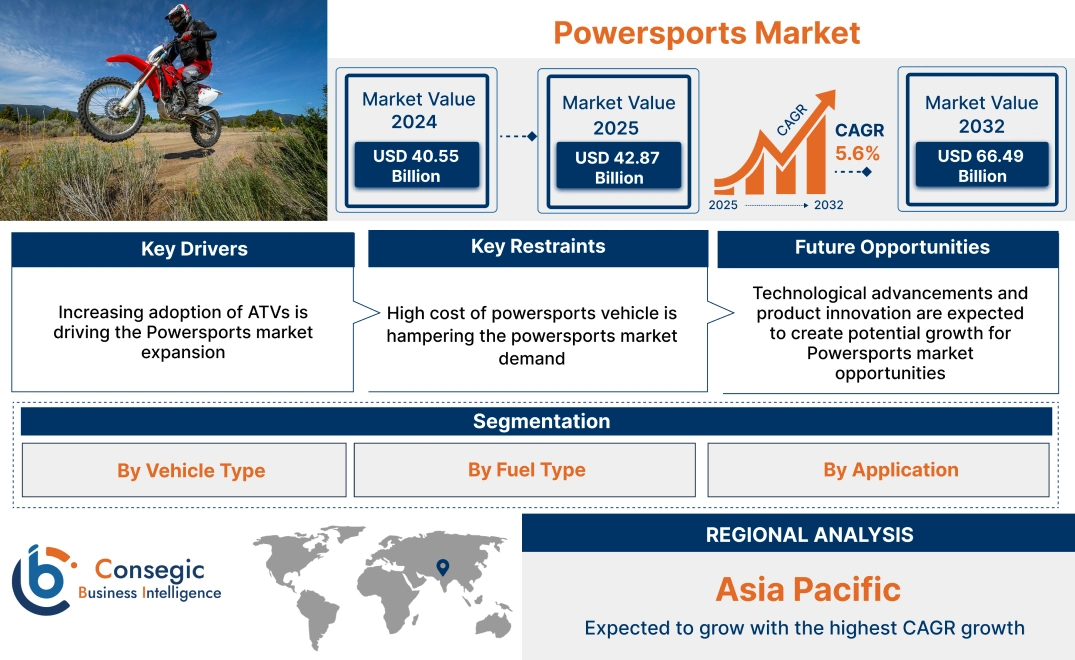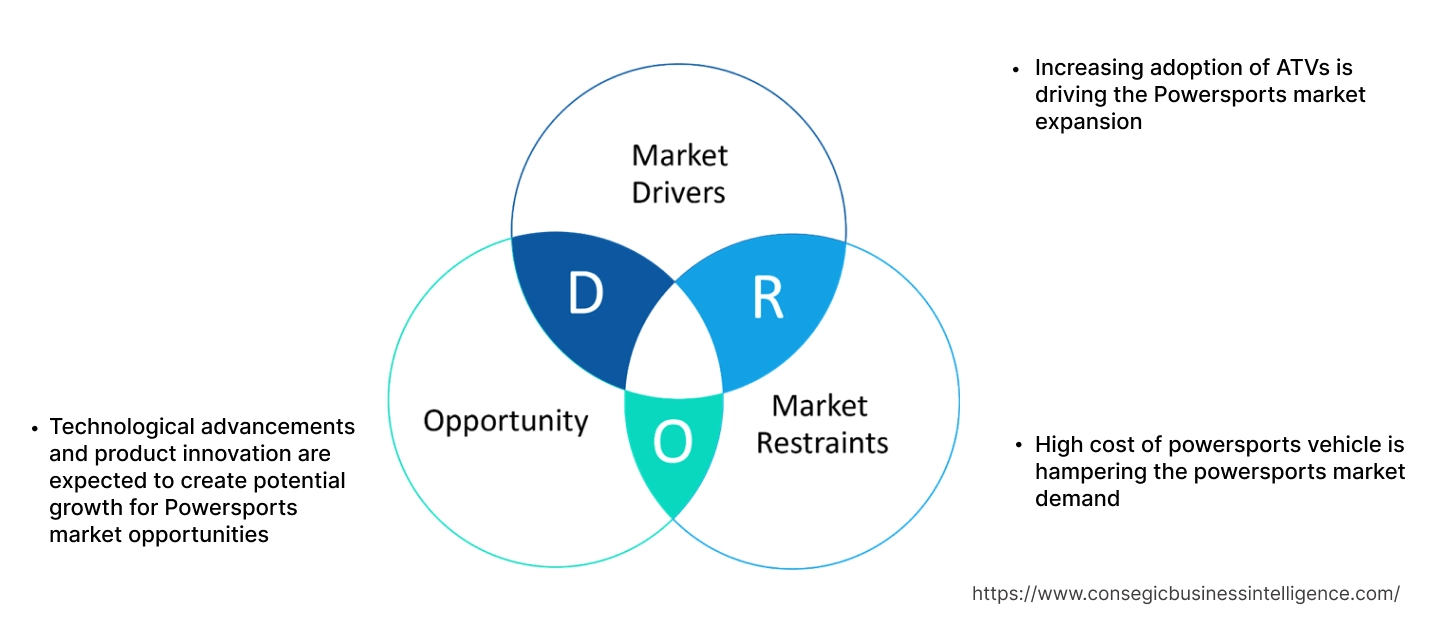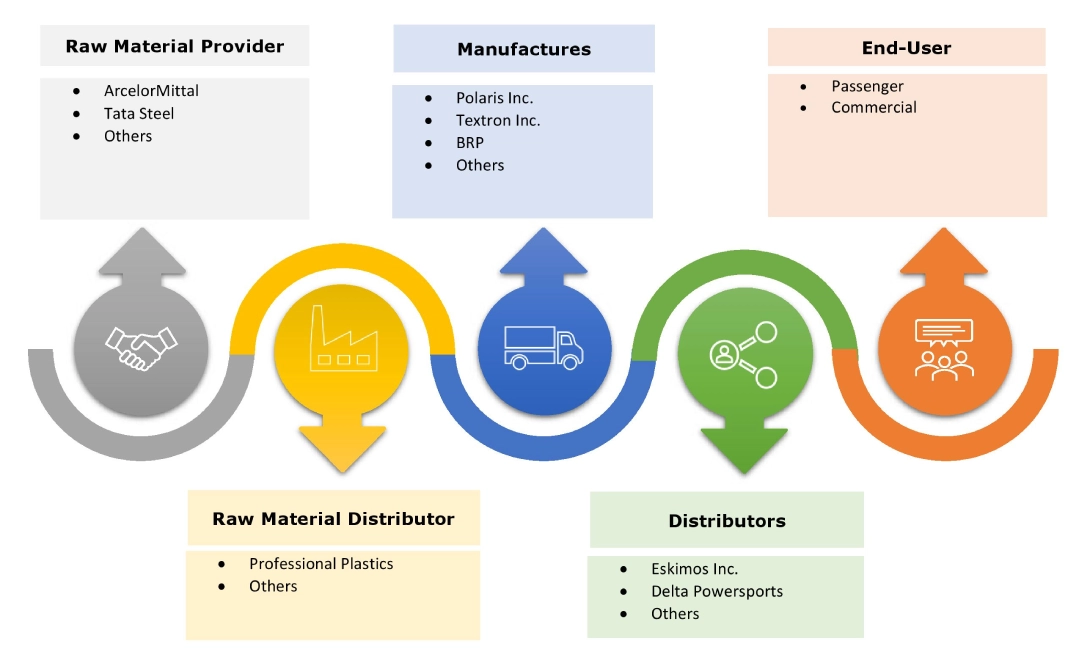- Summary
- Table Of Content
- Methodology
Powersports Market Size:
Powersports Market Size is estimated to reach over USD 66.49 Billion by 2032 from a value of USD 40.55 Billion in 2024 and is projected to grow by USD 42.87 Billion in 2025, growing at a CAGR of 5.6% from 2025 to 2032.
Powersports Market Scope & Overview:
Powersports refer to a variety of high-performance recreational and utility vehicles designed for different terrains and activities. This category includes motorcycles, all-terrain vehicles (ATVs), utility task vehicles (UTVs), snowmobiles, personal watercraft such as jet skis, and off-road vehicles. Powersports vehicles are characterized by their powerful engines and versatile capabilities, allowing users to participate in activities like racing, off-roading, water sports, and snowmobiling. These vehicles are favored by recreational enthusiasts seeking adventure as well as by professionals requiring reliable, high-performance machines for specialized tasks. The industry encompasses manufacturing, sales, maintenance, and aftermarket parts and accessories, fostering a vibrant community of riders and enthusiasts who appreciate the excitement and utility these vehicles offer.
Key Drivers:
Increasing adoption of ATVs is driving the Powersports market expansion
ATVs have fewer age restrictions and lower maintenance costs compared to other powersport vehicles, making them easier to maneuver due to their lighter weight. These factors, along with their affordability, have contributed to the popularity of powersports among both younger individuals and adults. ATVs serve as an excellent mobility solution in confined spaces and on narrow roads, particularly in parks, forests, and national parks, as they are agile and do not require much space. Additionally, their lower carbon footprints and reduced congestion are significant reasons consumers prefer ATVs and SxS vehicles.
- For instance, in January 2025, Honda America announced the arrival of side-by-side and ATV rosters. The models are available in two seating configurations and a total of seven distinct trim levels, while capable of navigating the most challenging terrains across riding areas nationwide. Additionally, the FourTrax Rubicon 4x4 stands as Honda's largest and most powerful ATV, engineered for both comfort and performance.
Thus, according to the powersports market analysis and trends, the increase in investments in ATVs is driving the powersports market size.
Key Restraints:
High cost of powersports vehicle is hampering the powersports market demand
The high cost of adventure sports vehicles poses a significant constraint on the market. Vehicles equipped with advanced technologies and premium features often carry substantial price tags, making them unaffordable for the average consumer. This financial barrier hinders market growth as potential buyers may choose more economical recreational activities. Additionally, ongoing maintenance, repair costs, and insurance premiums further elevate the total cost of ownership, rendering these vehicles a luxury rather than a necessity. Economic fluctuations and unstable disposable incomes can worsen this issue, impacting consumer purchasing power. Although financing options and leasing programs exist, they may not adequately alleviate the initial investment required, thereby limiting broader market penetration. Thus, the above factors are affecting the Powersports market growth.
Future Opportunities :
Technological advancements and product innovation are expected to create potential growth for Powersports market opportunities
Major manufacturers are advancing technology in adventure sports vehicles to maintain a competitive edge. This technological evaluation encompasses enhanced safety features such as traction control, advanced braking systems, and stability control. Furthermore, integrating smart technologies, including GPS navigation, digital displays, and wireless connectivity, enriches consumer experience and simplifies vehicle operation. Connectivity features such as GPS, smartphone integration, and diagnostic tools enhance convenience and usability, making Powersports vehicles more user-friendly. Industry leaders like Polaris and BRP are pioneering electric ATVs and snowmobiles that blend efficiency with power. These technological enhancements not only address the evolving demands of consumers but also create new market segments, thereby fostering powersports market growth.
The incorporation of advanced safety technologies is becoming standard in powersports vehicles. Innovations such as advanced braking systems, traction control, and stability control enhance user safety, appealing to a wider audience concerned with safety. Additionally, advanced suspension technologies play a crucial role in enhancing ride comfort and vehicle handling. These innovations significantly improve the performance of powersports vehicles, particularly in challenging terrains, which is essential for off-road applications.
- For instance, in January 2025, Advik announced the acquisition of Powersports MTG, to create additional expertise in premium motorcycle safety components and also drive technologies in internal combustion engine and electric-powered vehicles. The acquisition of MAGURA's two-wheeler braking system not only introduces technology for clutch systems and hydraulic braking to a broader global market but also enhances manufacturing and research and development capabilities in Germany.
Thus, based on the above analysis and trends, technological advancements in powersports is driving the Powersports market opportunities.
Powersports Market Segmental Analysis :
By Vehicle Type:
Based on vehicle type, the market is segmented into All-terrain Vehicles (ATV), SXS, Motorcycles, Snowmobiles, Snow Bikes, Personal Watercrafts, Side-by-Side Vehicles, and Others.
Trends in the Vehicle Type:
- The growing culture of motorsports and organized racing events are contributing the powersports market demand.
- Prominent manufacturers such as Harley-Davidson, Ducati, and KTM actively market their heavyweight motorcycles through racing events and exhibitions, enhancing community engagement and boosting visibility. This competitive landscape motivates consumers to invest in high-performance bikes that provide both excitement and prestige.
All-terrain Vehicle (ATV) segment accounted for the largest revenue share of 28.51% in the year 2024 and is expected to register the highest CAGR during the forecast period.
- The segment growth can be attributed to the growing popularity of outdoor recreational activities and the rising enthusiasm for off-road sports events. These leisure interests cater to adventure and drive demand for high-performance ATVs. For instance, events such as the Mud Nationals, scheduled for 2025 at the Sabine ATV Park in Burkeville, Texas, has attracted thousands of off-road supporters, while providing a platform for global manufacturers to showcase their latest innovations and engage with a growing customer base.
- The increasing use of ATVs in agriculture is fuelling the market growth. ATVs are revolutionizing farming operations by facilitating quicker and more efficient tasks. Farmers utilize these vehicles for various functions, such as transporting tools, equipment, and supplies across extensive fields. Furthermore, ATVs are well-suited for carrying fertilizers, distributing feed to livestock, and hauling harvested crops. Their compact size and manoeuvrability enable them to reach areas that larger machinery cannot, ensuring a seamless workflow even in rough or uneven landscapes.
- The need for ATVs from defense organizations is propelling the global market. For instance, in December 2023, Ukrainian forces received 20 ATV battle trucks, also known as light tactical vehicles, provided by volunteers. The Operational Command South of the country’s armed forces has been supplied with these vehicles, which were entirely manufactured through the efforts of an unpaid workers movement supported by major industrial enterprises.
- These trends and analysis in agriculture and defense sector would further drive the Powersports market size during the forecast period.
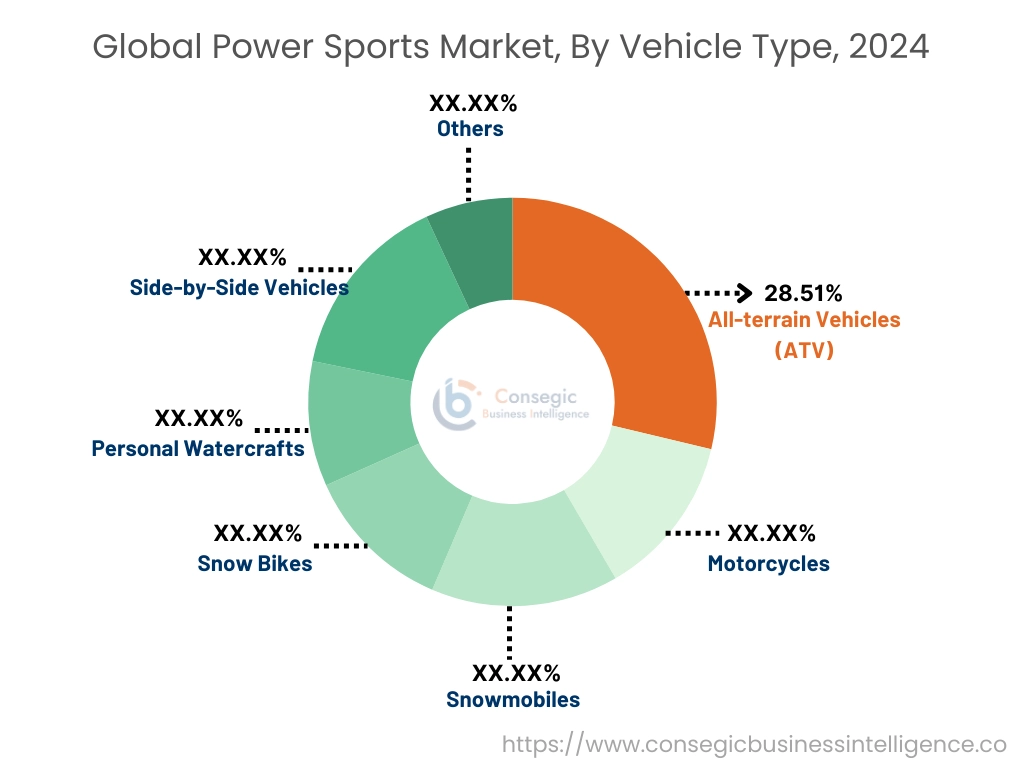
By Fuel Type:
Based on the fuel type, the Powersports market is segmented into gasoline, diesel, and fuel.
Trends in the fuel type:
- The increasing awareness of environmental concerns is propelling the advancement of more sustainable alternatives, including electric vehicles and alternative fuels.
- The ongoing advancements in engine technology, electronics, and materials are improving performance, safety, and comfort in Powersports vehicles.
Gasoline segment accounted for the largest revenue share in the year 2024.
- The segment growth can be attributed to the growing demand of high performance and reliability associated with gasoline engines. Vehicles such as motorcycles, ATVs, and personal watercraft are renowned for their power and speed, delivering thrilling experiences that appeal to adventure seekers. The performance capabilities of gasoline engines frequently exceed those of electric alternatives, establishing them as the favoured choice for off-road and racing contexts where power and agility are critical.
- The extensive network of fuel stations and maintenance services offers consumers convenient options for refuelling and servicing their vehicles during outings. This accessibility significantly contributes to the sustained popularity of gasoline-powered vehicles, particularly in remote areas where electric vehicle charging stations may be scarce.
- Affordability is another key factor driving the need for gasoline-powered vehicles. Generally, these vehicles come with a lower initial purchase price compared to electric models, making them more attainable for a wider range of consumers. Additionally, maintenance and repair costs for gasoline engines are often reduced, further increasing their appeal to budget-conscious buyers.
- Thus, on the above factors such as focus on gasoline-powered vehicles and need for high performance further supplement the global market during the forecast period.
Electric segment is anticipated to register the fastest CAGR during the forecast period.
- Electric vehicles in adventure sports are anticipated to increase their market share throughout the forecast period, driven by the growing need for eco-friendly recreational options. As awareness of environmentally friendly issues expands, users are increasingly seeking sustainable alternatives to conventional gasoline-powered vehicles. Electric motorsports vehicles, such as electric motorcycles, ATVs, and personal watercraft, provide zero-emission operation, appealing to environmentally conscious riders who wish to reduce their carbon footprint while enjoying outdoor activities.
- Technological advancements are also pivotal in advancing the electric powersports market. Innovations in battery technology have greatly enhanced the range and performance of electric vehicles, making them more suitable for recreational applications. Improved motor designs and powertrain engineering deliver superior acceleration and torque, offering exhilarating experiences that rival those of gasoline-powered vehicles. These advancements not only attract traditional adventure sports enthusiasts but also expand the market to include new consumers who prioritize both performance and sustainability.
- For instance, in November 2023, Pure EV has introduced the Pure ecoDryft 350 electric motorcycles, which boasts a range of 171 km on a single charge. This electric bike merges sustainability with practicality, providing an extended range ideal for commuting. With an emphasis on eco-friendly transportation, the Pure ecoDryft 350 addresses the increasing need for electric motorcycles that harmonize environmental responsibility with efficient performance.
- Thus, increasing investments in electric segment would further drive the Powersports market trends during the forecast period.
By Application:
Based on the application, the Powersports market is segmented into off-road, snow, on-road, marine, commercial, and defense.
Trends in the application:
- As economies expand and disposable incomes increase, a greater number of individuals can invest in recreational activities and high-performance vehicles.
- The favorable government policies, including the establishment of off-road trails and recreational areas, have the potential to enhance the global market.
Off-road segment accounted for the largest revenue share of in the year 2024 and is expected to register the highest CAGR during the forecast period.
- The off-road vehicle industry is undergoing a significant transformation due to evolving consumer demographics and preferences. As reported by the Sports and Industry Fitness Association (SFIA), the percentage of the United States population participating in outdoor sports reached around 57% in 2023, indicating a rising interest in outdoor activities. This change in consumer behaviour has prompted manufacturers to create more advanced and feature-laden vehicles, with companies like BRP Inc. introducing premium models such as the Can-Am Maverick R in August 2023, which boasts a 240-horsepower engine tailored for motorsports enthusiasts.
- Consistent government support for the development and proliferation of electric vehicles (EVs) has been a key factor contributing to the robust sales of electric three-wheelers in the adventure sports vehicle sector. Consequently, several original equipment manufacturers (OEMs) are focusing on these regions to introduce their three-wheeler models and capitalize on the opportunities presented by emerging markets.
- For instance, in March 2023, Zen Mobility launched its electric cargo three-wheeler. The vehicle features Zen’s EV drivetrain technology, 24 Nm of torque, a 2kW motor, and a range exceeding 120 km.
- Thus, the global requirement for electric vehicles across the globe would further supplement the Powersports market share during the forecast period.
Regional Analysis:
The global market has been classified by region into North America, Europe, Asia-Pacific, MEA, and Latin America.
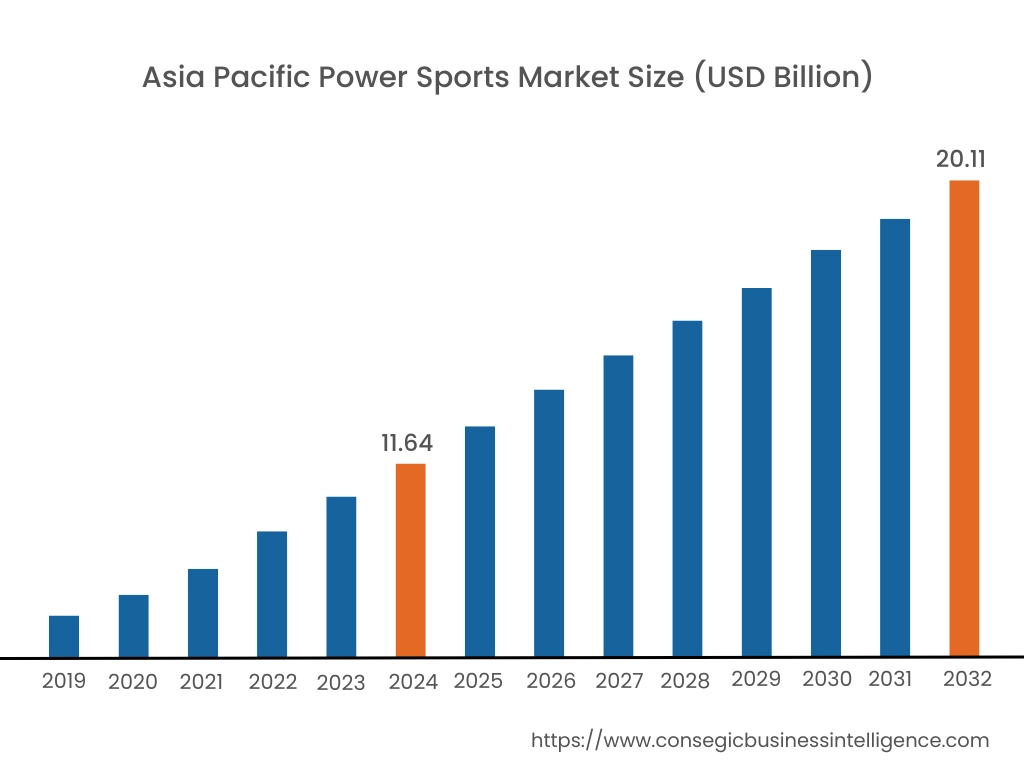
Asia Pacific Powersports market expansion is estimated to reach over USD 20.11 billion by 2032 from a value of USD 11.64 billion in 2024 and is projected to grow by USD 12.36 billion in 2025. Out of this, the Chinese market accounted for the maximum revenue split of 27.44%. The rising disposable incomes and a growing middle class in countries such as China, India, and Japan are enhancing consumer purchasing power, which is driving increased need for recreational vehicles, including motorcycles, ATVs, and personal watercraft. According to IMF, in 2023, the region's disposable income grew by 4.6 % from 3.9%, representing a significant rise from previous year. This economic improvement is accompanied by a heightened interest in adventure activities, particularly among younger generations seeking adventure and outdoor experiences. Additionally, government initiatives promoting eco-friendly transportation are further stimulating market growth by encouraging the adoption of electric and hybrid powersport vehicles. Regional countries are implementing stricter emission standards and offering incentives for electric vehicle purchases, aligning with the global movement towards sustainability. Moreover, the expansion of extreme sports and adventure tourism is cultivating a culture of outdoor recreation, contributing to the increasing popularity of adventure sports. These factors and analysis would further drive the regional market during the forecast period.
- For instance, in June 2024, Sichuan Jinjia Special Equipment Technology Co., Ltd. has introduced the Giant Lizard, an advanced all-terrain vehicle. Designed for versatility, it performs exceptionally well in navigating challenging terrains and withstanding extreme weather conditions, making it suitable for diverse environments, including marshes, deserts, landscapes, snowy, mudflats, and inland waters.
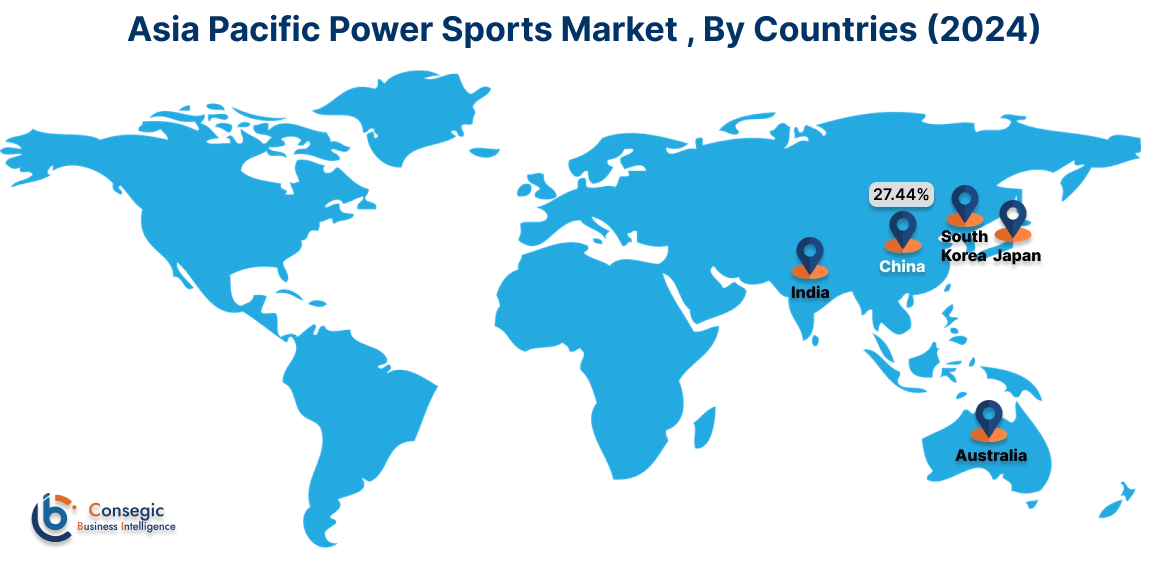
North America market is estimated to reach over USD 21.48 billion by 2032 from a value of USD 13.18 billion in 2024 and is projected to grow by USD 13.93 billion in 2025. The regional growth can be attributed to robust infrastructure, a thriving economy, and a strong culture of recreational activities. The area's expansive landscapes and varied terrain offer ideal settings for numerous motor sports adventures, drawing enthusiasts from around the world. North America maintains a significant market share, playing a crucial role in industry's development. Additionally, the U.S., with its extensive territory and diverse landscapes, holds a substantial portion of the regional market. The region's scenic vistas and deep-rooted recreational culture create a conducive environment for the rise of all-terrain vehicles and motorsports. Furthermore, a strong economy and effective marketing strategies have solidified the nation's leadership in this sector. With a wide array of offerings and broad accessibility, the U. S. stands out as a key contributor to outdoor adventure and leisure activities. These factors would further drive the regional Powersports market share during the forecast period.
- For instance, in April 2024, Octane Lending, Inc., a fintech company innovating the purchasing process for large recreational acquisitions, launched Dealer Portal 2.0, an upgraded and advanced version of its esteemed dealer platform. With this launch, Octane's over 4,000 Powersports and Outdoor Power Equipment (OPE) dealer partners can offer their customers a faster and more convenient financing process through Dealer Portal 2.0.
According to the Powersports industry analysis, the European market has seen robust progression in the coming years. As tourism expands, there is potential for a rise in businesses aimed at tourists interested in sports activities. These establishments may provide guided tours, equipment rentals, training sessions, and other services tailored to tourists' needs. Additionally, governments and local authorities might invest in infrastructure development to support sports activities in response to the increased tourism in Europe. This could involve creating designated trails, tracks, or rental facilities, as well as enhancing access roads and parking areas in popular tourist destinations. Additionally, the huge demand for ATVs agriculture and industrial purposes in Brazil, Argentina, and Chile is expected to drive the Latin American market. Moreover, sports vehicles, including electric scooters, e-bikes, and compact motorcycles, are becoming increasingly popular among urban commuters seeking efficient, agile, and environmentally friendly transportation solutions. Manufacturers are creating urban-oriented vehicles featuring compact designs, electric powertrains, and advanced connectivity options to meet the need of riders. Additionally, Saudi Arabia's diverse landscapes, encompassing deserts, mountains, and coastlines, provide a wealth of opportunities for off-roading, dune bashing, and other adventure activities, appealing to both domestic and international tourists. Thus, based on the above powersports market analysis and trends, these factors would further drive the regional market during the forecast period.
Top Key Players and Market Share Insights:
The global powersports market is highly competitive with major players providing outdoor sport products to the national and international markets. Key players are adopting several strategies in research and development (R&D), product innovation, and end-user launches to hold a strong position in the market. Key players in the powersports industry include-
- Polaris Inc. (U.S.)
- Textron Inc. (U.S.)
- Alpina (Germany)
- KTM (Austria)
- Deere & Company (U.S.)
- Honda Motor Co., Ltd. (Japan)
- BRP (Canada)
- Harley Davidson (U.S.)
- Kawasaki Heavy Industries, Ltd. (Japan)
- Suzuki Motor Corporation (Japan)
Recent Industry Developments :
Product Lauch:
- In March 2023, Honda Motors has launched a new line of multipurpose ATVs and compact Side by Sides (SxS). These vehicles are designed with a refined body suitable for various terrains, offering enhanced weight endurance and comfort features.
Powersports Market Report Insights :
| Report Attributes | Report Details |
| Study Timeline | 2019-2032 |
| Market Size in 2032 | USD 66.49 Billion |
| CAGR (2025-2032) | 5.6% |
| By Vehicle Type |
|
| By Fuel Type |
|
| By Application |
|
| By Region |
|
| Key Players |
|
| North America | U.S. Canada Mexico |
| Europe | U.K. Germany France Spain Italy Russia Benelux Rest of Europe |
| APAC | China South Korea Japan India Australia ASEAN Rest of Asia-Pacific |
| Middle East and Africa | GCC Turkey South Africa Rest of MEA |
| LATAM | Brazil Argentina Chile Rest of LATAM |
| Report Coverage |
|
Key Questions Answered in the Report
How big is the Powersports market? +
Powersports Market Size is estimated to reach over USD 66.49 Billion by 2032 from a value of USD 40.55 Billion in 2024 and is projected to grow by USD 42.87 Billion in 2025, growing at a CAGR of 5.6%from 2025 to 2032.
Which is the fastest-growing region in the Powersports market? +
Asia-Pacific is the region experiencing the most rapid growth in the market. The high costs of vehicles and the limited servicing infrastructure hinder the adoption of powersports in this region. However, due to an increase in disposable income and greater consumer awareness of recreational activities, there is a growing demand for heavyweight motorcycles and side-by-sides. Therefore, these factors are expected to promote market growth in this region.
What specific segmentation details are covered in the Powersports report? +
The Powersports report includes specific segmentation details for vehicle type, fuel type, application, and region.
Who are the major players in the Powersports market? +
The key participants in the market are Polaris Inc. (U.S.), Textron Inc. (U.S.), Honda Motor Co., Ltd. (Japan), BRP (Canada), Harley Davidson (U.S.), Kawasaki Heavy Industries, Ltd. (Japan), Suzuki Motor Corporation (Japan), Alpina (Germany), KTM (Austria), Deere & Company (U.S.), and others.
